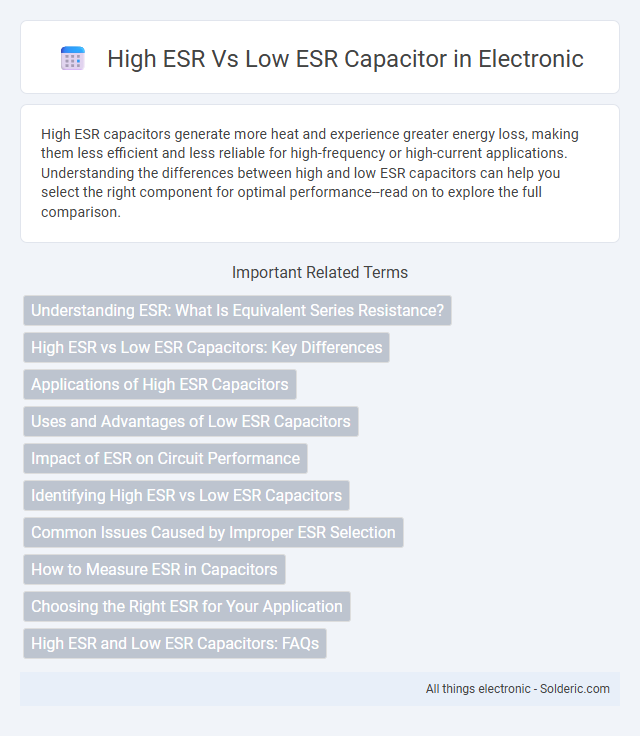High ESR capacitors generate more heat and experience greater energy loss, making them less efficient and less reliable for high-frequency or high-current applications. Understanding the differences between high and low ESR capacitors can help you select the right component for optimal performance--read on to explore the full comparison.
Comparison Table
| Feature | High ESR Capacitor | Low ESR Capacitor |
|---|---|---|
| ESR (Equivalent Series Resistance) | High ESR value, typically > 50 mO | Low ESR value, typically < 10 mO |
| Heat Generation | Higher heat dissipation due to resistance | Lower heat generation, suitable for high current |
| Efficiency | Lower efficiency in high-frequency circuits | Higher efficiency, preferred in switching regulators |
| Application | Power smoothing, filtering in low-frequency circuits | Power supply decoupling, high-frequency filtering, RF circuits |
| Life Span | Shorter lifespan under high ripple currents | Longer lifespan with stable performance |
| Cost | Generally lower cost | Higher cost due to advanced materials |
Understanding ESR: What Is Equivalent Series Resistance?
Equivalent Series Resistance (ESR) represents the internal resistance within a capacitor that causes energy dissipation as heat during operation, affecting its efficiency and performance. High ESR capacitors exhibit greater power loss and reduced lifespan due to increased heat generation, while low ESR capacitors ensure better conductivity, higher efficiency, and improved reliability in high-frequency or high-current applications. Your choice between high and low ESR capacitors directly influences circuit stability, thermal management, and overall component durability.
High ESR vs Low ESR Capacitors: Key Differences
High ESR (Equivalent Series Resistance) capacitors exhibit higher internal resistance, causing increased power loss and heat generation, which can reduce efficiency and lifespan in high-frequency or high-current applications. Low ESR capacitors minimize energy dissipation, improve performance in switching power supplies, and provide better stability under rapid charge-discharge cycles. Choosing the right ESR level for your capacitor ensures optimal functionality and durability based on the specific demands of your electronic circuit.
Applications of High ESR Capacitors
High ESR capacitors are commonly used in power supply filtering applications where high ripple currents and elevated temperatures are present, such as in switch-mode power supplies and motor drives. Their inherent resistance helps dampen high-frequency noise and stabilize voltage fluctuations, making them suitable for audio equipment and automotive electronics. You can rely on high ESR capacitors in circuits requiring robust energy absorption and improved durability under harsh operating conditions.
Uses and Advantages of Low ESR Capacitors
Low ESR capacitors are commonly used in high-frequency circuits, power supplies, and switching regulators due to their ability to minimize energy loss and heat generation. Their low equivalent series resistance improves efficiency, enhances performance, and extends the lifespan of electronic devices. You benefit from increased reliability and better thermal management when incorporating low ESR capacitors into your designs.
Impact of ESR on Circuit Performance
High ESR capacitors cause increased power dissipation and voltage drops, leading to reduced efficiency and potential overheating in high-frequency circuits. Low ESR capacitors minimize energy loss and improve transient response, enhancing the overall stability and reliability of power supply and filtering applications. Your choice of capacitor directly affects the performance and longevity of sensitive electronics, making ESR a critical parameter in design optimization.
Identifying High ESR vs Low ESR Capacitors
High ESR capacitors exhibit higher equivalent series resistance, causing increased heat generation and reduced efficiency in high-frequency applications, while low ESR capacitors maintain minimal resistance for better performance and longevity. You can identify high ESR capacitors through specific markings, manufacturer datasheets indicating ESR values, or by using an ESR meter during testing. Choosing the appropriate capacitor type depends on your circuit requirements, where low ESR capacitors are favored for power supplies and high-current applications.
Common Issues Caused by Improper ESR Selection
High ESR capacitors can cause excessive heat buildup, reduced efficiency, and accelerated component aging in power supplies and audio circuits. Low ESR capacitors, while beneficial for stability and ripple reduction, may lead to instability or oscillations if not properly matched to the circuit requirements. Your choice of ESR must align with the specific application to prevent malfunction, noise issues, and premature failure.
How to Measure ESR in Capacitors
Measuring ESR in capacitors involves using an ESR meter or an LCR meter set to measure equivalent series resistance at a specific frequency, typically 100 kHz, to ensure accurate results. You connect the meter leads directly to the capacitor terminals, avoiding circuit interference by testing the capacitor out of circuit or on a functioning board with careful probe placement. Accurate ESR readings help determine capacitor health, with high ESR indicating degradation or failure, and low ESR signifying good component condition.
Choosing the Right ESR for Your Application
Selecting the appropriate Equivalent Series Resistance (ESR) in capacitors depends on the specific needs of your application, with high ESR capacitors providing better filtering for high-frequency noise and improved stability in power supply circuits. Low ESR capacitors are ideal for high-frequency switching power supplies and applications requiring low power loss and heat generation. Analyzing the operational environment, load conditions, and frequency response is crucial to optimize performance and longevity while minimizing energy dissipation.
High ESR and Low ESR Capacitors: FAQs
High ESR (Equivalent Series Resistance) capacitors exhibit greater internal resistance, resulting in higher heat generation and reduced efficiency in high-frequency applications, while low ESR capacitors provide better performance with minimal energy loss and improved reliability. You should select low ESR capacitors for power supply circuits and high-frequency switching to ensure stable voltage and longer component lifespan. FAQs often highlight differences in thermal management, ripple current tolerance, and suitability for specific electronic devices.
High ESR vs low ESR capacitor Infographic

 solderic.com
solderic.com